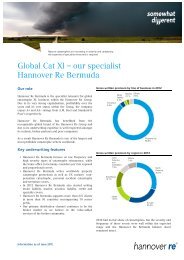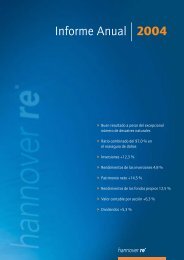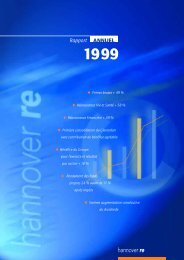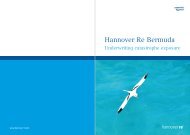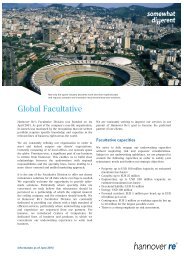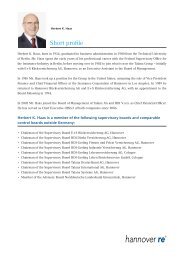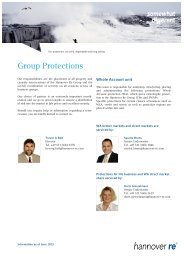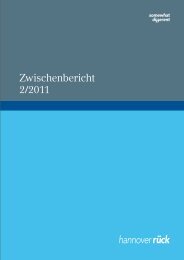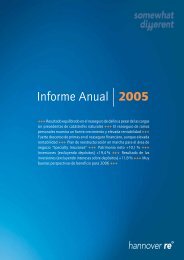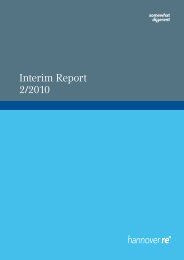Annual Report 2010 - Hannover Re
Annual Report 2010 - Hannover Re
Annual Report 2010 - Hannover Re
You also want an ePaper? Increase the reach of your titles
YUMPU automatically turns print PDFs into web optimized ePapers that Google loves.
Sensitivity analysis of the Market Consistent Embedded Value (MCEV) 1,2<br />
Base values in EUR million 2009 2008<br />
Base value 3,390.3 2,421.6<br />
Interest rate curve +100 basis points 2.2% 0.5%<br />
Interest rate curve –100 basis points –2.2% –0.3%<br />
Costs –10% 1.3% 1.1%<br />
Lapse +10% –5.5% +0.6%<br />
Lapse –10% 10.2% –1.4%<br />
Mortality +5% –15.5% –9.6%<br />
Mortality –5% 21.6% 13.2%<br />
1 More extensive information is provided in the MCEV reports published on our website. The presentation is based on the principles for publication<br />
of the MCEV defined by the CFO Forum. The CFO Forum is an international organisation of Chief Financial Officers from major insurance and<br />
reinsurance enterprises.<br />
2 Before consolidation, excluding minority interests<br />
published on 4 May <strong>2010</strong> (valid as of 31 December 2009), the lated fluctuations in fair value and realised gains/losses on<br />
table shows the MCEV 2009 and its sensitivity to selected scenarios<br />
in comparison with the corresponding sensitivities of maximum loss amount, with an eye to clearly graduated trig-<br />
investments since the beginning of the year in relation to a<br />
the MCEV 2008.<br />
ger values. These are unambiguously defined in conformity<br />
with our risk appetite and trigger specified actions if a corresponding<br />
fair value development is overstepped. Owing to the<br />
The change in the MCEV under the scenarios shown captures<br />
the low volatility in this area and reflects our portfolio’s high favourable capital market environment in the year under review,<br />
the trigger utilisation in the <strong>2010</strong> financial year was con-<br />
degree of diversification. The consolidated MCEV before minority<br />
interests amounted to EUR 2,210.8 million (2008: EUR sistently above the escalation levels – as shown by the graph<br />
1,652.0 million) as at 31 December 2009. This represents an on the following page.<br />
increase of 33.8% (4.3%). The operating MCEV earnings<br />
totalled EUR 178.5 million (EUR 172.4 million), while the The short-term “Value at Risk” (VaR) is another vital tool used<br />
value of new business stood at EUR 83.9 million (EUR 150.5 for monitoring and managing market price risks. The VaR is<br />
million). The increase in the mortality sensitivities can be attributed<br />
to the business with a high mortality exposure written the securities positions under own management and the cor-<br />
determined on the basis of historical data, e.g. the volatility of<br />
in 2009. This new business also reacts sensitively to changes relation between these risks. As part of these calculations the<br />
in the lapse rate, hence additionally causing lapse sensitivities decline in the fair value of our portfolio is simulated with a<br />
to rise. For more detailed information please see the Market given probability and within a certain period. The VaR of the<br />
Consistent Embedded Value <strong><strong>Re</strong>port</strong> 2009. We shall publish the <strong>Hannover</strong> <strong>Re</strong> Group determined in accordance with these<br />
MCEV for the <strong>2010</strong> financial year on our Internet website at principles specifies the decrease in the fair value of our securities<br />
portfolio under own management that with a probability<br />
the same time as the quarterly report for the first quarter of<br />
2011.<br />
of 95% will not be exceeded within ten trading days. A multifactor<br />
model is used to calculate the VaR indicators for the<br />
Market risks<br />
<strong>Hannover</strong> <strong>Re</strong> Group. It is based on time series of selected<br />
We pursue an investment policy in which the primary emphasis<br />
is on the stability of the generated return. With this in spread curves, exchange rates, commodity prices and macro-<br />
representative market parameters (equity prices, yield curves,<br />
mind, our portfolio is guided by the principles of broad diversification<br />
and a balanced risk/return ratio. Risks in the investries<br />
are reduced by analysis to a sensible number of main<br />
economic variables). All correlations between these time sement<br />
sector consist primarily of market, credit default and liquidity<br />
risks. The most significant market price risks are share individual positions through the APT model, i.e. the market<br />
components. All asset positions are mapped on the level of<br />
price, interest rate and currency risks.<br />
price risks of all individual positions are reduced through<br />
mathematical operations to the market price risk factors of the<br />
With a view to preserving the value of our assets under own model. <strong>Re</strong>sidual risks (e.g. market price risks that are not directly<br />
explained by the multi-factor model) can be determined<br />
management, we constantly monitor adherence to a trigger<br />
mechanism based on a clearly defined traffic light system that through back-calculation and are accommodated in the overall<br />
is applied across all portfolios. This system puts the accumu-<br />
calculation on the supposition of non-correlation.<br />
Management report<br />
<strong>Hannover</strong> <strong>Re</strong> Group annual report <strong>2010</strong><br />
opportunity and risk report Management report<br />
63



